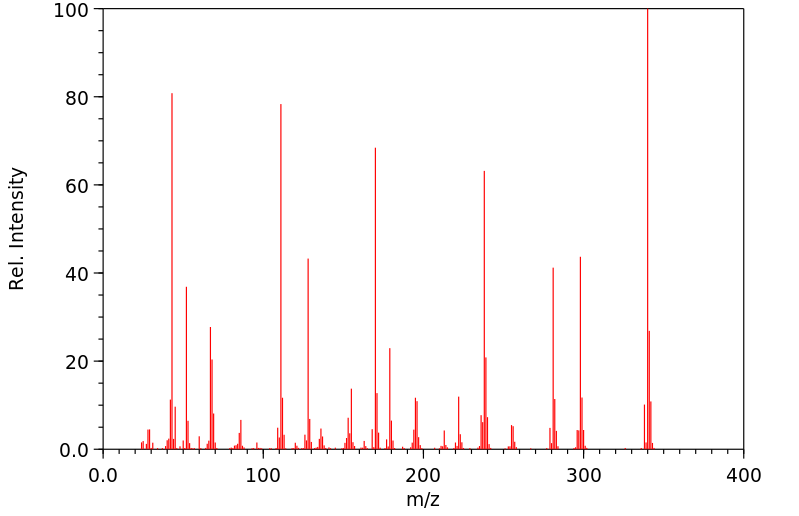tetra-μ-acetato-dichromium(II) | 15020-15-2
中文名称
——
中文别名
——
英文名称
tetra-μ-acetato-dichromium(II)
英文别名
chromous tetraacetate;[Cr2(μ-CH3CO2)4];[Cr2(OAc)4];tetra-μ-acetatodichromium;chromium acetate;chromium(2+);tetraacetate
CAS
15020-15-2
化学式
C8H12Cr2O8
mdl
——
分子量
340.17
InChiKey
COSOKRWKZBULAU-UHFFFAOYSA-J
BEILSTEIN
——
EINECS
——
-
物化性质
-
计算性质
-
ADMET
-
安全信息
-
SDS
-
制备方法与用途
-
上下游信息
-
文献信息
-
表征谱图
-
同类化合物
-
相关功能分类
-
相关结构分类
计算性质
-
辛醇/水分配系数(LogP):-4.98
-
重原子数:18
-
可旋转键数:0
-
环数:0.0
-
sp3杂化的碳原子比例:0.5
-
拓扑面积:161
-
氢给体数:0
-
氢受体数:8
反应信息
-
作为反应物:描述:参考文献:名称:Albert Cotton; Lon Thompson, Inorganic Chemistry, 1981, vol. 20, # 4, p. 1292 - 1296摘要:DOI:
-
作为产物:描述:tetrakis(acetato)dichromium(II) dihydrate 以 neat (no solvent) 为溶剂, 生成 tetra-μ-acetato-dichromium(II)参考文献:名称:Cotton, F. Albert; Chen, Hong; Daniels, Lee M., Journal of the American Chemical Society, 1992, vol. 114, # 23, p. 8980 - 8983摘要:DOI:
文献信息
-
Precursors for Assembly of Supramolecules Containing Quadruply Bonded Cr <sub>2</sub> <sup>4+</sup> Units: Systematic Preparation of Cr <sub>2</sub> (formamidinate) <i> <sub>n</sub> </i> (acetate) <sub> 4– <i>n</i> </sub> ( <i>n</i> = 2–4)作者:F. Albert Cotton、Zhong Li、Carlos A. MurilloDOI:10.1002/ejic.200700414日期:2007.8Four quadruply bonded dichromium complexes with mixed-ligand sets, Cr2(formamidinate)n(acetate)4–n (n = 2–4), were synthesized from reactions of anhydrous Cr2(O2CCH3)4 and formamidinate anions. The Cr–Cr bond lengths fall in the range for “supershort” Cr–Cr bonds as they vary from 1.8897(5) A to 2.012(1) A. The distance variation depends on the presence or absence of weak axial interactions. Because
-
t-Butyl isocyanide complexes of rhenium(I), chromium(O), tungsten(O,I) and platinum(II); X-ray crystal structures of bis(t-butylisocyanide)- tris(trimethylphosphine)chlororhenium(I) and tris(t-butylisocyanide)bis(trimethyl- phosphine)chlororhenium(I)作者:Kwok W. Chiu、Christopher G. Howard、Geoffrey Wilkinson、Anita M.R. Galas、Michael B. HursthouseDOI:10.1016/0277-5387(82)80007-7日期:——ReCl 4 (THF) 2 in the presence of excess t -butylisocyanide by sodium amalgam produces pentakis ( t -butylisocyanide)chlororhenium(I), which has been converted to the corresponding methyl and ethyl derivatives. The reaction of pentakis(trimethylphosphine)chlororhenium(I) with Bu t NC gives partially substituted complexes, ReCl(CNBu t ) 2 (PMe 3 ) 3 and ReCl(CNBu t ) 3 (PMe 3 ) 2 . The structures of摘要在过量叔丁基异氰化物存在下,汞齐钠可还原ReCl 4(THF)2生成五(叔丁基异氰化物)氯r(I),已将其转化为相应的甲基和乙基衍生物。五(三甲基膦)氯r(I)与Bu t NC的反应得到部分取代的配合物ReCl(CNBu t)2(PMe 3)3和ReCl(CNBu t)3(PMe 3)2。两种化合物的结构均已通过X射线方法确定。八面体ReCl(CNBu t)2(PMe 3)3具有反式异氰酸酯基,其中一个线性[CNC = 175(1)°]和一个稍微弯曲的[CNC = 159(1)°]。Re C键的长度在实验误差范围内相等[2.004(7),2.003(7)A]。在八面体的ReCl(CNBu t)3(PMe 3)2中,由于无序,结构没有很好地定义,独特的异氰酸酯向氯的反式在氮原子处显着弯曲[C Nˆ C = 141(6)°],对于其他两种异氰酸酯而言,似乎显示出最短的Re C键长度,分别为1
-
New Complexes of Chromium(III) Containing Organic π-Radical Ligands: An Experimental and Density Functional Theory Study作者:Mei Wang、Jason England、Thomas Weyhermüller、Swarna-Latha Kokatam、Christopher J. Pollock、Serena DeBeer、Jingmei Shen、Glenn P.A. Yap、Klaus H. Theopold、Karl WieghardtDOI:10.1021/ic302743s日期:2013.4.15(iPrNH2) [CrIII(bpy•)(iPrNH2)2(CH3CO2)2]0 (S = 1) (2) was obtained. Both 1 and 2 contain a CrIII ion and a single (bpy•)1– ligand, so are not low-spin CrII species. One-electron oxidation of 1 and 2 yielded [CrIII(bpy0)2(CH3CO2)2]PF6 (S = 3/2) (3) in both cases. In addition, the new neutral species [CrIII(DAD•)3]0 (S = 0) (4) and [CrIII(CF3AP•)3]0 (S = 0) (5) have been synthesized. Both complexes contain three一系列铬配合物的电子结构1 - 7已经用X射线晶体学,磁和电化学的组合被实验研究,以及Cr K-边缘X射线吸收和UV-VIS光谱。二聚体的反应[CR II 2(μ-CH 3 CO 2)4 ] 0与2,2'-联吡啶(BPY 0)中产生的复合物[CR III(BPY 0)(BPY •)(CH 3 CO 2)2 ] 0(S = 1)(1),但在异丙胺(i PrNH 2)存在下[Cr III(bpy •)(i PrNH 2)2(CH 3 CO 2)2 ] 0(S = 1)(2)。既1和2含有铬III离子和单(BPY •)1-配体,所以是不低自旋铬II物种。1和2的单电子氧化产生[Cr III在两种情况下均为(bpy 0)2(CH 3 CO 2)2 ] PF 6(S = 3/2)(3)。此外,新的中性物种[Cr III(DAD •)3 ] 0(S = 0)(4)和[Cr III(CF 3 AP •)3
-
Strong electronic influence of equatorial ligands on frontier orbitals in paddlewheel dichromium(<scp>ii</scp>,<scp>ii</scp>) complexes作者:Po-Jung Huang、Yoshiki Natori、Yasutaka Kitagawa、Yoshihiro Sekine、Wataru Kosaka、Hitoshi MiyasakaDOI:10.1039/c8dt04347g日期:——A series of substituted benzoate-bridged dichromium(II,II) complexes [Cr2(RCO2)4(THF)2] ([Cr2]), where RCO2− is substituted benzoate, was synthesized and its structural and magnetic properties were investigated. The orbital energies, as well as magnetic coupling energies, were also investigated using computational approaches. The HOMO/LUMO energy levels of the complexes are strongly dependent on the
-
Trimethylsilylmethyl and other alkyls of chromium, molybdenum, ruthenium, and rhodium from interaction of magnesium dialkyls with metal–metal bonded binuclear acetates of chromium(<scp>II</scp>), molybdenum(<scp>II</scp>), ruthenium(<scp>II</scp>,<scp>III</scp>), and rhodium(<scp>II</scp>)作者:Richard A. Andersen、Richard A. Jones、Geoffrey WilkinsonDOI:10.1039/dt9780000446日期:——The interaction between dialkylmagnesium MgR2(R = Me, CH2SiMe3, or CH2CMe3) and binuclear transition-metal acetates M2II(O2CMe)4(M = Cr, Mo, and Rh) and Ru2II,III(O2CMe)4CI, containing metal–metal bonds in the presence of trimethylphosphine yields either monomeric or dimeric alkyls. In the latter the metal–metal bond is retained as in Mo2Me4(PMe3)4 or Mo2(ButCH2)2(O2CMe)2(PMe3)2. Loss of a hydrogen二烷基镁MgR 2(R = Me,CH 2 SiMe 3或CH 2 CMe 3)与双核过渡金属乙酸盐M 2 II(O 2 CMe)4(M = Cr,Mo和Rh)和Ru 2之间的相互作用II,III(O 2 CMe)4 CI,在三甲基膦的存在下含有金属-金属键,可生成单体或二聚烷基。在后一种的金属-金属键是在沫保持为2我4(PME 3)4或Mo 2(BU吨CH 2)2(O 2 CMe)2(PMe 3)2。CH 2 SiMe 3的甲基中氢的损失导致金属环的形成[省略图] H 2和[省略图] H 2。已经通过1 H,13 C和31 P nmr和红外光谱研究了各种化合物,并报道了通过X射线晶体学测定结构的结果。
表征谱图
-
氢谱1HNMR
-
质谱MS
-
碳谱13CNMR
-
红外IR
-
拉曼Raman
-
峰位数据
-
峰位匹配
-
表征信息
同类化合物
(甲基3-(二甲基氨基)-2-苯基-2H-azirene-2-羧酸乙酯)
(±)-盐酸氯吡格雷
(±)-丙酰肉碱氯化物
(d(CH2)51,Tyr(Me)2,Arg8)-血管加压素
(S)-(+)-α-氨基-4-羧基-2-甲基苯乙酸
(S)-阿拉考特盐酸盐
(S)-赖诺普利-d5钠
(S)-2-氨基-5-氧代己酸,氢溴酸盐
(S)-2-[[[(1R,2R)-2-[[[3,5-双(叔丁基)-2-羟基苯基]亚甲基]氨基]环己基]硫脲基]-N-苄基-N,3,3-三甲基丁酰胺
(S)-2-[3-[(1R,2R)-2-(二丙基氨基)环己基]硫脲基]-N-异丙基-3,3-二甲基丁酰胺
(S)-1-(4-氨基氧基乙酰胺基苄基)乙二胺四乙酸
(S)-1-[N-[3-苯基-1-[(苯基甲氧基)羰基]丙基]-L-丙氨酰基]-L-脯氨酸
(R)-乙基N-甲酰基-N-(1-苯乙基)甘氨酸
(R)-丙酰肉碱-d3氯化物
(R)-4-N-Cbz-哌嗪-2-甲酸甲酯
(R)-3-氨基-2-苄基丙酸盐酸盐
(R)-1-(3-溴-2-甲基-1-氧丙基)-L-脯氨酸
(N-[(苄氧基)羰基]丙氨酰-N〜5〜-(diaminomethylidene)鸟氨酸)
(6-氯-2-吲哚基甲基)乙酰氨基丙二酸二乙酯
(4R)-N-亚硝基噻唑烷-4-羧酸
(3R)-1-噻-4-氮杂螺[4.4]壬烷-3-羧酸
(3-硝基-1H-1,2,4-三唑-1-基)乙酸乙酯
(2S,4R)-Boc-4-环己基-吡咯烷-2-羧酸
(2S,3S,5S)-2-氨基-3-羟基-1,6-二苯己烷-5-N-氨基甲酰基-L-缬氨酸
(2S,3S)-3-((S)-1-((1-(4-氟苯基)-1H-1,2,3-三唑-4-基)-甲基氨基)-1-氧-3-(噻唑-4-基)丙-2-基氨基甲酰基)-环氧乙烷-2-羧酸
(2S)-2,6-二氨基-N-[4-(5-氟-1,3-苯并噻唑-2-基)-2-甲基苯基]己酰胺二盐酸盐
(2S)-2-氨基-N,3,3-三甲基-N-(苯甲基)丁酰胺
(2S)-2-氨基-3-甲基-N-2-吡啶基丁酰胺
(2S)-2-氨基-3,3-二甲基-N-(苯基甲基)丁酰胺,
(2S)-2-氨基-3,3-二甲基-N-2-吡啶基丁酰胺
(2S,4R)-1-((S)-2-氨基-3,3-二甲基丁酰基)-4-羟基-N-(4-(4-甲基噻唑-5-基)苄基)吡咯烷-2-甲酰胺盐酸盐
(2R,3'S)苯那普利叔丁基酯d5
(2R)-2-氨基-3,3-二甲基-N-(苯甲基)丁酰胺
(2-氯丙烯基)草酰氯
(1S,3S,5S)-2-Boc-2-氮杂双环[3.1.0]己烷-3-羧酸
(1R,5R,6R)-5-(1-乙基丙氧基)-7-氧杂双环[4.1.0]庚-3-烯-3-羧酸乙基酯
(1R,4R,5S,6R)-4-氨基-2-氧杂双环[3.1.0]己烷-4,6-二羧酸
齐特巴坦
齐德巴坦钠盐
齐墩果-12-烯-28-酸,2,3-二羟基-,苯基甲基酯,(2a,3a)-
齐墩果-12-烯-28-酸,2,3-二羟基-,羧基甲基酯,(2a,3b)-(9CI)
黄酮-8-乙酸二甲氨基乙基酯
黄荧菌素
黄体生成激素释放激素(1-6)
黄体生成激素释放激素 (1-5) 酰肼
黄体瑞林
麦醇溶蛋白
麦角硫因
麦芽聚糖六乙酸酯
麦根酸







